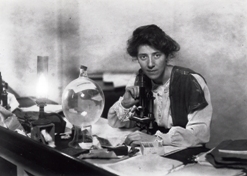
Science writer and historian Nina Morgan on why Marie Stopes might have done for Robert Falcon Scott with her palaeobotanical talk...
Geoscientist 18.6 June 2008
By all accounts Marie Stopes (1880-1958), best known for her book Married Love and her promotion of birth control, was a very persuasive woman. Perhaps less known is that she was also a brilliant scientist. She specialised in palaeobotany, and was appointed as an assistant lecturer in botany at Manchester University in 1904.
Her great interest was in the study of coal and coal balls, and she went down coal mines to collect many of the specimens herself. Inspired by a desire to prove Eduard Suess's Gondwanaland theory, she was particularly keen to obtain fossils of Glossopteris, or seed ferns, from Antarctica. So, when the explorer Robert Falcon Scott visited Manchester on a fundraising trip, she tried to convince him to let her join the expedition. She failed. But Scott was charmed, and promised to do all he could to bring back the fossils she wanted.
It was a promise Scott took very seriously. Exhausted, dispirited, cold and short of food after losing the race to the pole, Scott's diary records that he and his companions camped and spent 'the rest of the day geologising … under cliffs of Beacon sandstone, weathering rapidly and carrying veritable coal seams. From the last, Wilson, with his sharp eyes, has picked several plant impressions, the last a piece of coal with beautifully traced leaves in layers, also some excellently preserved impressions of thick stems, showing cellular structure…'
These specimens were found along with their bodies and, noted Frank Debenham, an Australian scientist who survived the expedition, they 'are perhaps the most important of all the geological results. The plant fossils collected by this party are the best preserved of any in this quadrant of the Antarctic, and are of the character best suited to settle a long-standing controversy between geologists as to the nature of the former union between Antarctica and Australasia.'